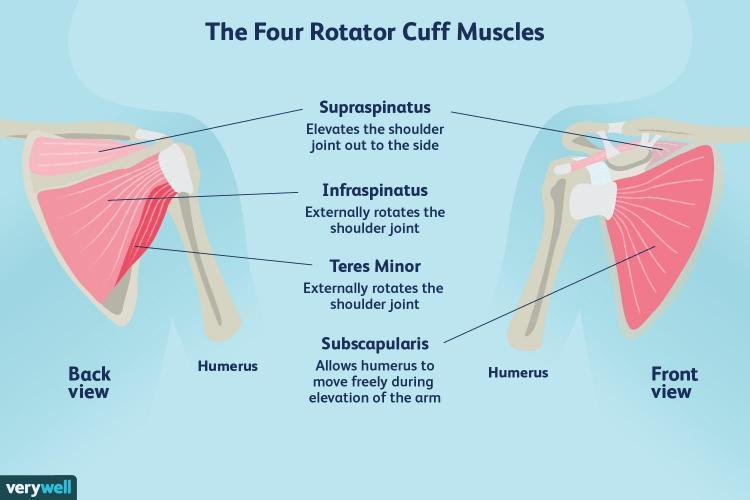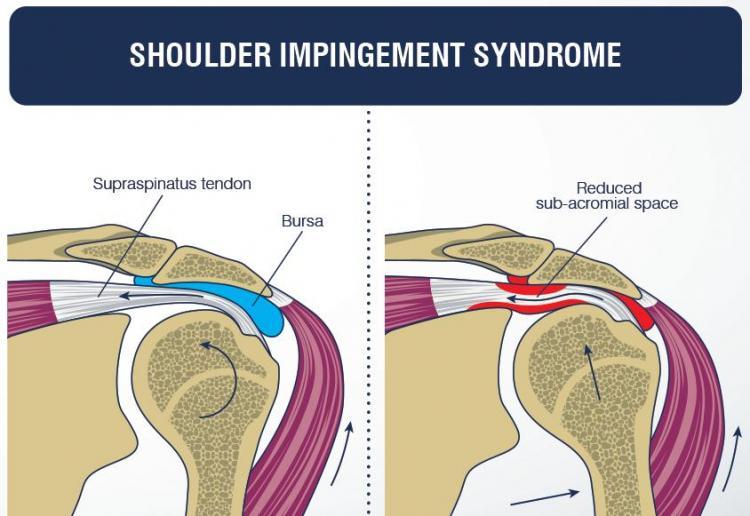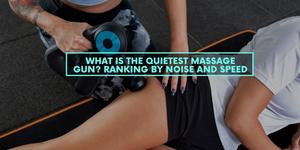Jimmy Dowolemi, a 4th-year medical student from New York, has written the following article. I tore my rotator cuff a few years back. But for awhile, some of the physical therapists and doctors were diagnosing it as just rotator cuff impingement.
Rotator cuff injuries are very common amongst athletes that rely on their shoulders for the bulk of their activities and movements. That is why you find it so common among martial artists. Not a lot of people know the level of impact these injuries can have on their art or general lives if not properly dealt with. Here’s what you need to know about rotator cuff injuries and how to manage them.
Anatomy of the Rotator Cuff

The rotator cuff is a significant part of the shoulder composition. It consists of the muscles and tendons that enclose the shoulder joint – making the head (ball) of your upper arm bone (the humerus) stay within the socket of your shoulder blade. It is made up of four different muscles. They are:
| Rotator cuff muscle | Function and range of motion |
|---|---|
| supraspinatus muscle | holds the humerus in place and allows you to lift your arm |
| infraspinatus muscle | majorly allows for shoulder rotation and extension |
| teres minor | assists with shoulder rotation |
| subscapularis muscle | rotates the arm internally |
The rotator cuff not only protects your shoulder joint but also allows you to move your arm in different directions, especially over your head.

The Majority of movements made by athletes in one way or the other involve the shoulders, and martial combatants aren’t left out. So imagine when the rotator cuff is affected and you’re unable to rotate your arms properly or even lift them high enough to make impacting punches?
That shows how big of a deal the rotator cuff is to you and your art. What happens when your shoulders don’t work like they used to? In relation to the rotator cuff, there are two major types of injuries that can affect the shoulders. They are the rotator cuff tear and the rotator cuff impingement. It’s important to clarify the differences between the two, so you can tell one from the other.
Symptoms of the Rotator Cuff Impingement

This rotator cuff injury most times, leads to the other. But just because it’s not a total tear doesn’t make it any less serious. When you have a rotator cuff impingement, it means that the tendons that enclose your shoulder joint have been injured and are now swollen (inflamed).
When the bone in the joint comes in contact with these injured tendons, it causes steady pinching that keeps getting worse as more movements are made with the arm.
Rotator cuff impingement could go from a simple inflammation of the tendons to gradual thickening and scarring of the associated bursa (a saclike cavity found between the head of humerus and top of the shoulder that prevents friction) and then to relapse of the rotator cuff which is the last stage (the rotator cuff tear).
There are a number of reasons why people develop rotator cuff impingements. For older people, it’s more of wear and tear on the shoulders’ tendons through the years. But more often than not –especially for athletes – it’s as a result of repetitive movement of the shoulders, or a traumatic fall or direct injury to the shoulder.
Maintaining postures like having your arms directly over your head, working your arms through shoulder height, or the usually rounded shoulder posture amongst boxers can, over time, expose the shoulders to impingement.
The major indicator for a rotator cuff impingement is pain in the shoulder. At its earliest stage, the pain comes occasionally but with sharp effects. Overtime, it becomes more of a persistent ache. The pain is experienced whenever you;
- attempt to put your hand behind your back or across your chest
- raise your hands over your head or at shoulder height
- lie on your shoulder
- make simple swinging or motion movements
- attempt to lift or reach for objects or persons
Arm weakness can accompany any of these symptoms. It’s important to note that the symptoms vary with different people. You may still be able to carry out your usual activities, only that they are now done with extra effort and pain.
Symptoms of the Rotator Cuff Tear
A rotator cuff tear is simply a tear that occurs within the rotator cuff tendons in your shoulder. It’s usually of two kinds – the partial tear where one of the rotator cuff muscles gets damaged, and the complete tear, which goes beyond the muscles into the tendon and damages it or completely pulls it off the bone.
While the rotator cuff tear can be the final stage of a rotator cuff impingement (when it isn’t taken care of), it can also occur on its own by sudden traumatic injuries like falling and lifting heavy loads.
The more common cause of rotator cuff tear amongst athletes however, is repeated injuries that occur over time, which could even span over the years. When the rotator cuff tendons get injured, and there’s a continuous straining of the shoulders, it can cause the tendons to tear completely.
Most of the symptoms of this injury are similar to that of the rotator cuff impingement, only that there’s an undeniable weakness in the shoulder that accompanies the pain. It’s normal not to notice the strength lost when a rotator cuff tear occurs. But eventually, here are some of the symptoms you may experience;
- trouble raising your arm
- pain moving your arms or throwing punches
- major weaknesses lifting anything above shoulder level
- powerless punches (for boxers and martial athletes generally)
- popping and clicking sounds with any movement in your shoulders
Torn rotator cuffs can lead to major problems if not attended to early enough. It can cause total stiffness in the shoulder, which is harder to fix up.
2 Tests You Can Do at Home
Now, it’s very important for a certified doctor to examine you to give an exact diagnosis of what your rotator cuff state is through either an MRI, X-ray, or Ultrasound. There are a number of tests you can run on yourself at home to have an idea what you’re dealing with. Whenever you’re feeling pain in your shoulders like some of those described above, here are some of the tests you can run on yourself;
Lateral Jobe test
This particular test looks to check your supraspinatus muscles for any form of weakness and may need the assistance of another person to carry out.
You start by raising your injured arm at 90 degrees. Afterward, rotate the arm in a way that your palm and thumb are facing backward. Then, your assistant can apply force on your arm in a downward direction while you try fighting back the force. While resisting the force, if you feel sharp and difficult pain, then there’s a chance that your rotator cuff is injured, and it’s an impingement.
For people 35 and above, amongst other tests, the lateral jobe test generally gives a sensitivity rate of 88%, a specificity of 62% with a confidence ratio of 2.3. This means that the test is most likely to be positive (a rotator cuff impingement) when an injured supraspinatus muscle is tested.
Shoulder Drop Arm Test
This test is also meant to assess the weakness of the supraspinatus muscle. You’ll again need an assistant with this and can be done from a standing or sitting position. You want to see if your injured arm can be elevated and held away from your body as much as possible.
If you can raise your arm straight to a 90-degree angle, try it. And if you can’t, ask your assistant to help you raise it. After it’s been raised, try to lower the extended arm back to its position in a controlled but slow manner.
If the lowering of the arm is painful or you are unable to complete it as a result of the pain, it’s more likely a tear than an impingement. Remember, you can have both at the same time. But if are unable to complete the shoulder drop arm test, it is likely than you have a tear.
Amongst other test, the shoulder drop arm test generally gives an average sensitivity of 24% and specificity of 96% with a confidence ratio of 6.45. This means that you can be sure that you have a rotator cuff tear if the test is positive, but a negative tear may not provide conclusive information.
The sensitivity and specificity numbers cited above are from a study by Nitin Jain et al. in 2012.
Exercises to Strengthen the Rotator Cuff
Athletes who have an injured rotator cuff should do strength and flexibility exercises. Athletes can do the following conditioning program to heal from a rotator cuff injury.
Side-lying Shoulder External Rotation
To follow through with this exercise, here’s what to do:
1. On a firm surface, while holding any lightweight object in your upper hand, lie on the side of your body,
2. Then bend the top elbow a whole 90 degrees, making sure that the upper arm is against the side of your body, and the arm carrying the lightweight is resting on the floor in front of your body,
3. Rotate your arm at the shoulder area and bring the weight the way of the ceiling,
4. Then lower the arm with the weight back to the position it was from the start.
To reduce the stress on your shoulder while doing this exercise, you should put a small towel under your armpit.
Pendulum
This is how you do this exercise:
1. Leaning forward with one arm hanging. Using the other arm, brace against a chair or railing for support.
2. Then swing your hanging arm gently to the side, back and forth , as well as circular motions.
3. Return to an upright position, slowly.
Article written by Jimmy Dowolemi, a 4th-year medical student at the University of California San Diego School of Medicine.





